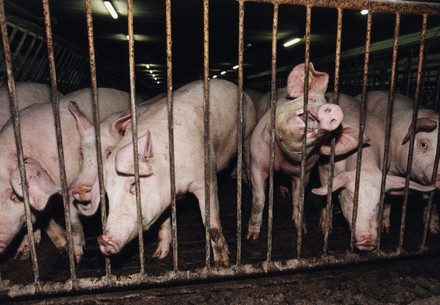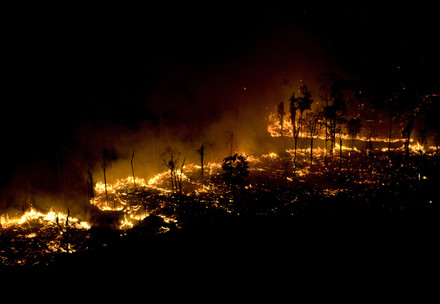Climate and Animal Welfare
An estimated 83.3 billion farmed animals worldwide are slaughtered for meat every year. Animal agriculture makes up around 1/6th of all manmade greenhouse gas emissions. Farming cows for the production of beef and dairy alone causes 2/3th of all global animal agriculture emissions. Factory farming in the meat and dairy industry not only exploits billions of animals but also fuels the climate crisis immensely.
Every Meal Counts
What we eat matters. Every meal has the power to shape the future.
Why is FOUR PAWS working on climate change?
Have you heard about the idea of “One Welfare”? It means that animal welfare, human health and the well-being of the environment are heavily interconnected. So let’s connect the dots: factory farming destroys the planet and has the potential to breed the next pandemic – which is bad for human health. In turn: If we eat fewer animals and more plant-based food, it is good for animals, humans and the planet.
What are the climate campaigns at FOUR PAWS?
As an animal welfare organization, we are alarmed about the unfolding climate crisis. Therefore, we have various campaigns and projects exposing the harmful practices of the meat and dairy industry that exploits billions of animals, people and our planet and demanding a food systems transformation.
In our Meat Exhaustion day report, we looked at the meat consumption per country. We calculated when a country would exceed its 'sustainable' meat consumption defined by the Planetary Health Diet. This is a reference diet of the renowned scientific EAT-Lancet Committee, which looks into the environmental and health impacts of food.
We frequently attend climate strikes and protests related to animal agriculture in countries all around the globe.
Our policy experts also make sure to give a voice to the animals in political settings like the UN Climate Conferences or the European Parliament.
How is meat related to climate change?
Globally, the livestock industry generates 16.5% of our total global greenhouse gas emissions. It is the second-highest source of emissions and amounts to more than the entire transport sector - all of the world’s cars, trucks, ships and airplanes combined¹.
On top of that, animal agriculture is the leading contributor to biodiversity loss, acid rain, coral reef degeneration, deforestation and water pollution².
When land is used to raise animals instead of crops, precious water and soil are lost, trees are cut down to clear the land for feed production and factory farms and untreated animal waste pollutes rivers and streams.
The world’s cattle alone consume more food than the caloric needs of the entire human population on Earth³ — a massive waste of energy.
To save the climate, we have to reduce our consumption of meat and finally end factory farming. Meat has such a devastating impact on all aspects of our environment that the Union of Concerned Scientists lists it as one of the biggest environmental hazards facing the Earth.
1. Your Questions About Food and Climate Change, Answered. NYTimes, 2019
2. Livestock a major threat to environment. FAO Newsroom, 2006.
How is animal agriculture harming the climate?
Cows, sheep and other ruminants emit a very powerful greenhouse gas called methane. This happens through a process called ‘enteric fermentation’ that occurs in their stomachs and intestines when digesting grass and other feed.
Also, the feed production itself is quite climate-harming. Almost half of farm animal-related emissions are caused by the production and processing of animal feed such as grass and feed crops.1 Feed production and grazing pastures alone take up 77% of the world’s agricultural land.2
The manure of ruminants but also pigs for example also releases greenhouse gas emissions, especially nitrous oxide. This gas is 273 times more potent than CO2. Manure alone makes up 13% of all nitrous oxide emissions. An additional 54% of all nitrous oxide emissions come from urine and dung from farmed animals kept on pastures or rangeland.3 Making animal agriculture, by far the biggest emitter of nitrous oxide.
How exactly do cows emit methane?
Well, cows are ruminants, just like sheep and goats. A process called ‘enteric fermentation’ that occurs in their stomachs and intestines when digesting feed, contributes to greenhouse gas emissions as it releases methane (CH4). Ruminants are responsible for 89% of the total CH4 emissions of animal agriculture, while animals like chickens and pigs contribute only 11%. Among ruminants, cattle contribute to the majority of methane production at 69% of the total.4
Therefore, emissions from farmed animals are the largest source of agricultural emissions with enteric fermentation being the predominant process and cattle the main animal causing these emissions.
So, are cows killing the climate?
No. According to the FAO, farmed cattle (raised for both beef, milk and inedible outputs like manure and draft power) are the animal species responsible for about 62% of animal agriculture’s emissions.5 However, it is us humans that breed these animals for our consumption. We simply keep too many farm animals. The ones to blame for the climate crisis are meat and dairy giants as well as politicians who are ignoring the harmful impacts of factory farming to animals and the planet.
What can I do personally?
When it comes to climate friendly behavior, we talk a lot about sustainable sources of energy and transport. However, a very effective way to lower your personal carbon footprint is through your diet. The consumption of cheap meat supports the dysfunctional factory farming industry that causes immense animal suffering and is a key contributor to climate change.
To take action, FOUR PAWS recommends the 3 R’s principle. That is to: Reduce the number of animal products that are consumed as much as possible, Refine the selection of animal products that are consumed to the most sustainable and cruelty-free option on offer and to Replace as many animal products as possible with tasty, cruelty-free and climate-friendly alternatives.
What is a climate friendly diet?
A climate-friendly diet is one which has the least impact on our animals and the environment. On average, the production of meat and other animal-based products have a much greater carbon footprint than plant-based alternatives. Therefore, a climate-friendly diet includes choosing more plant-based, and whenever possible, regional and seasonal oriented diet, which automatically contributes the reduction of meat and other animal-based products being consumed.
More and more people around the world are interested in animal welfare labels and the demand for plant-based meat-alternatives is skyrocketing. This is a global movement that can change our world for the better — with your help!
Note: Any advertisements that may appear during the viewing of this video are unrelated to FOUR PAWS. We assume no liability for this content.
Learn More about the Climate
Source
2. United Nations Environment Programme. What’s Cooking? An assessment of the potential impacts of selected novel alternatives to conventional animal products. United Nations Environment Programme; 2023. https://wedocs.unep.org/20.500.11822/44236. doi:10.59117/20.500.11822/44236
3. Dangal SRS, Tian H, Xu R, Chang J, Canadell JG, Ciais P, Pan S, Yang J, Zhang B. Global Nitrous Oxide Emissions From Pasturelands and Rangelands: Magnitude, Spatiotemporal Patterns, and Attribution. Global Biogeochemical Cycles. 2019;33(2):200–222. doi:10.1029/2018GB006091
4. FAO. Pathways towards lower emissions. FAO; 2023. http://www.fao.org/documents/card/en/c/cc9029en. doi:10.4060/cc9029en
5. FAO. Pathways towards lower emissions. FAO; 2023. http://www.fao.org/documents/card/en/c/cc9029en. doi:10.4060/cc9029en












